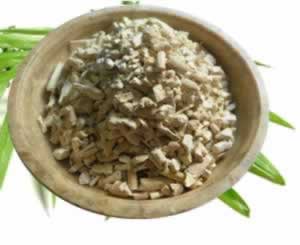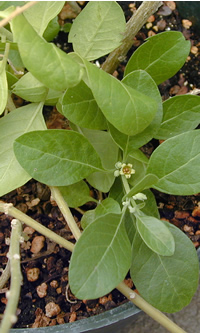Ashwagandha Withania somnifera

Ashwagandha dried root
- Common Names
- Ashwagandha root , Ashwaganda, Ajagandha, Indian ginseng, Winter cherry
- Botanical Name
- Withania somnifera
- Family
- SOLANACEAE
Medicinal Uses & Benefits of Ashwagandha Root
![]() How to Use|
Side Effects |
Plant & Garden|
Folklore
How to Use|
Side Effects |
Plant & Garden|
Folklore
- Medicinal Uses: * Aphrodisiac
* Ayurvedic
* Hypertension
* Libido
* Liver
* Longevity Tonics
* Lupus
* Rheumatoid_arthritis
* Stress
- Properties: * Abortifacient * Adaptogens * Anodyne * Anti-inflammatory * AntiViral * Aphrodisiac * Diuretic * Febrifuge * Hepatic * Hypotensive * Sedative * Stress * Tonic
- Parts Used: root, leaves
- Constituents: withanolides, glycosides, alkaloids
How to Use: Ashwagandha
Ashwagandha is often touted as the Indian version of ginseng because, like ginseng, ashwagandha is revered as a non-specific tonic and adaptogen. Adaptogens are important in cases of ongoing, chronic stress. Ashwagandha root rejuvenates without being over stimulating, so is more useful than ginseng in weakened and debilitated persons.
Ashwagandhas acts as a mild sedative, and as indicated by its botanical name somnifera, it promotes restful, deep sleep. Ayurvedic medicine has used ashwaganda as a general tonic for centuries and this herb may be just the thing for today's stressed and burned out populace. 1
One of the chemically active ingredients found in the leaves of ashwagandha is withanolides. These phytochemicals appear to have a steroid like effect, meaning that they indirectly increase activity of steroidal hormones like testosterone and progesterone. Because of testosterone's effect on sex drive, this could be what is behind ashwagandha's purported aphrodisiac effects. 2
Withanolide D has shown antibiotic and antitumor activities as well.3 Ashwagandha may prove to be a beneficial adjunct treatment like other standard therapeutics for fatigue, such as exercise, in those undergoing chemotherapy. 4
Ashwagandha also relaxes blood vessels and stimulates circulation and has an anti-inflammatory and tonic effect in rheumatic and autoimmune conditions such as rheumatoid arthritis and lupus. Animal studies have found that naturally occurring steroids in ashwaganda are more potent than treatment with the synthetic steroid hydrocortisone for controlling inflammation.5 Ashwagandha is also used in the treatment of low back pain and sciatica.
Preparation Methods & Dosage :.
Ayurvedic Medicine
 Mildly warming. Ayurvedic physicians prescribe the root as an all purpose tonic, a grounding herb that stabilizes mood.
Mildly warming. Ayurvedic physicians prescribe the root as an all purpose tonic, a grounding herb that stabilizes mood.
Ashwagandha Side Effects: Not recommended during pregnancy, except under the care of an experienced herbal practitioner.
Plant Description

Withania somnifera plant
- Flowers:Yellow flowers, small, berry-like red fruit
- Plant type:Shrub, up to 5 ft in height
- Medicinal part:Whole herb
- Distribution:India, Pakistan, and Sri Lanka.
Regional Traditions :Ayurvedic *
How to Grow Ashwagandha
Hardy annual/Tender perennial. Scarifying seed will help in germination. Prefers rich,loose soil, moderate water, full sun. Collect leaves in the spring, fruit in the fall, and root after berries drop.
History and Traditions & Folklore
Ashwaganda is a Hindi name meaning "horse's smell." The term refers not only to the smell of a horse, but also to a horse's strength.
- James Duke. "The Green Pharmacy Herbal Handbook" Rodale Books, (2000) Ashwagandha also seems to mimic gamma-amino-butytric acid (GABA), a naturally occuring substance in the brain whose role is to decrease the effect of stimuli that reach the brain.
- Karta Purkh Singh Khalsa & Michael Tierra. "Ayurvedic Herbs, The Way Of" Lotus Press, (2008) Ashwagandhas acts as a mild sedative, and as indicated by its botanical name somnifera, it promotes restful, deep sleep.
- Phyllis A. Balch. "Prescription for Herbal Healing" Avery, (2002) Animal studies have found that naturally occurring steroids in ashwaganda are more potent than treatment with the synthetic steroid hydrocortisone for controlling inflammation.
- Biswal BM, Sulaiman SA, Ismail HC, Zakaria H, Musa KI. . Adjunct Treatment with Ashwagandha Root Extract for Fatigue from Chemotherapy for Breast Cancer , American Botanical Council - Herbalgram, (06-14-2013): In summary, those patients with cancer who were taking ashwagandha had lower degrees of fatigue and a higher QoL during chemotherapy than the patients in the control group.,

- Hoffmann, David . Medical Herbalism , Healing Arts Press, (2010): Withanolide D, one of the active constituents of ashwaganda has been shown to have antibiotic and antitumor activities.,











